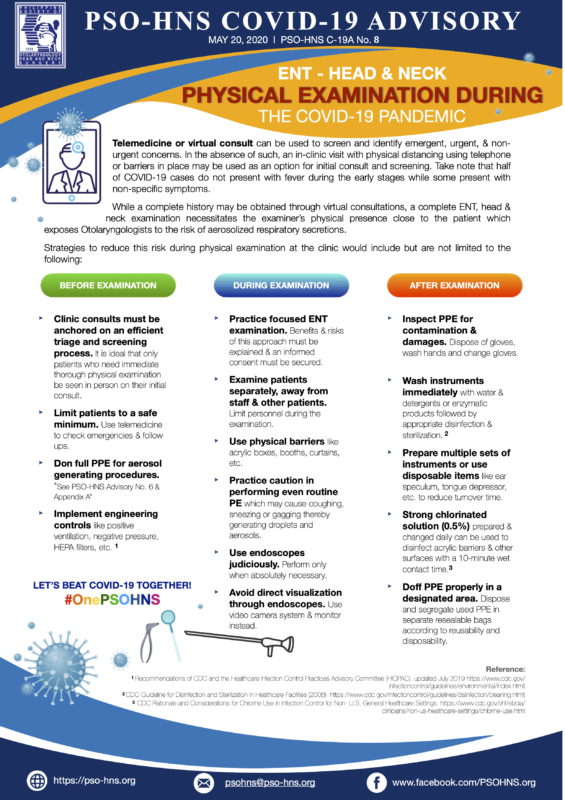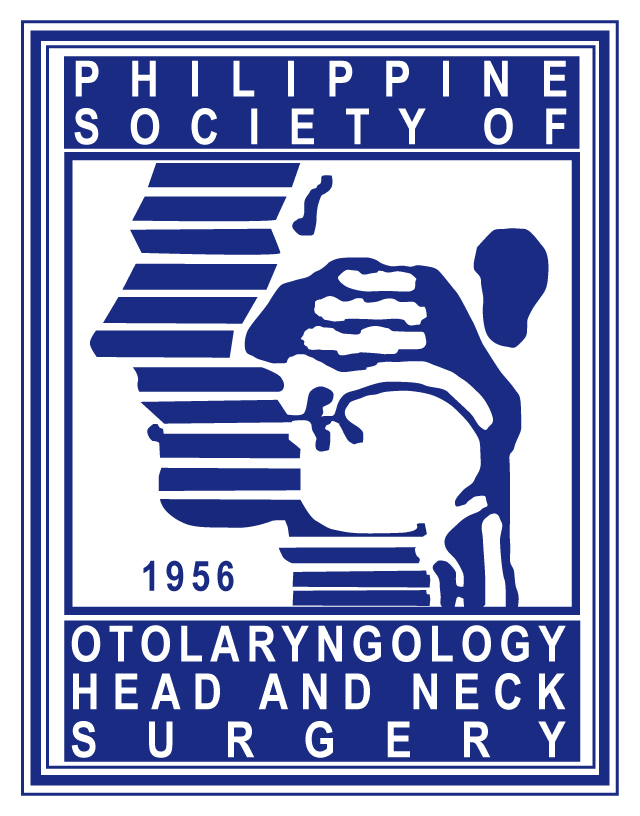
INTRODUCTION
A complete history and physical examination (PE) are important tools of the physician in obtaining a diagnosis for the patient. Unfortunately, in this time of the COVID-19 pandemic, performing the routine Otorhinolaryngologic PE carries with it a high risk of exposure to SARS-CoV-2. The nose and oral cavity are known to carry high loads of SARS-CoV-2 in patients with COVID-19. Even a strict triaging and screening process may not completely protect the physician because it is possible even for asymptomatic and presymptomatic carriers to transmit the virus via direct contact, respiratory droplets and, possibly, also via aerosols.
One way to circumvent this is to perform history and PE remotely via telemedicine. And yet, though an examination of external structures and the oral cavity is possible, other structures (i.e. middle ear, nasal cavity, nasopharynx, larynx) require special instrumentation by the Otolaryngologist.
It is the goal of this advisory to provide recommendations that will allow the Otorhinolaryngologist to perform the necessary PE and procedures while minimizing the potential risk of exposure. This advisory is based on current evidence and circumstances and is subject to change with evolving knowledge of the disease. It is geared primarily for areas with high local transmission and the clinician is encouraged to adopt the strategies best-suited to the local COVID-19 burden, approved policies and resource availability.
A. PREPARATION
All in-clinic consults must be anchored on an efficient triage and screening process. Half of COVID-19 cases do not present with fever during the early stages while some present with non-specific symptoms. Thus, it is ideal that only patients who need urgent thorough physical examination that is needed for management decisions, and whose needs cannot be fully addressed via telemedicine, be seen in person.
The number of outpatients to be seen should be limited to a safe minimum. Though difficult in our setting, establishing a comprehensive patient scheduling system that provides the specific time of clinic visit, and the use of telemedicine for follow up, monitoring, and surveillance of previously seen patients is a necessary investment during this “new normal”. These strategies can reduce walk-in consults, and provide efficient healthcare delivery while maintaining adequate physical distancing in the work space. Always consider (1) the physical capacity and resources of the clinic; (2) time for cleaning, disinfecting, and sterilization of the clinic equipment, instruments, and other surfaces; and (3) the time that one should spend for proper donning and doffing of PPE in between patients to estimate the number of patients to be accommodated.
Otolaryngologists frequently perform aerosol generating procedures (AGP), hence a well-designed Heating, Ventilation, and Air Conditioning (HVAC) system is ideal for ORL-HNS clinics. In its absence, preferred air quality standards can be achieved by addressing the air entry-exit flow directions, use of filtration devices, and setting the air changes per hour (ACH) to the recommended minimum of 12 ACH for an AGP workplace. Take note that the effectiveness of portable filtration units (e.g. portable high-efficiency particulate air or HEPA filter) is also dependent on the room configuration, the furniture and persons in the room, and the placement of the unit relative to the contents and layout of the room. (Please see PSO-HNS C-19A Appendix D series: part 1, part 2, part 3)
Because ENT examination basically exposes Otolaryngologists to droplets and aerosols, full PPE is recommended when performing these procedures in the clinic. This includes: (1) surgical cap, (2) goggles and/or face shield, (3) N95 mask, its equivalent, or a higher filtration mask, (4) waterproof gown or coverall, (5) clean gloves and (6) shoe cover. Equally important as the availability of the PPE is its proper donning, mask seal check, and doffing that must only be performed in the designated and isolated area. (Please see PSO-HNS C-19A No. 6)
B. EXAMINATION
Examine patients separately, away from staff and the other patients. In a hospital setting, having a designated equipped facility for endoscopy and AGPs may be utilized to limit the individual clinics to non-AGPs and maintain a safer workspace. On the other hand, creating designated clean and dirty zones in the clinic may also be achieved by using transparent barriers like plastic curtains, acrylic boxes, booths, etc.
Limit personnel during the examination. The presence of a companion inside the room during examination is not encouraged. If this cannot be avoided such as in the case of minors, elderly or persons with disability requiring assistance, the companion should wear the same level of PPE as the physician. The name and contact details of the accompanying person should be obtained to allow for easier communication should contact tracing be necessary in the future.
Practicing a focused ENT examination is advised with a straightforward complaint-directed approach. The reason and benefits, as well as the risks of this approach should be explained well to the patient and should also be included in the clinic’s informed consent form.
During examinations, always be cognizant that numerous otolaryngologic procedures may induce certain reflexes such as sneezing, coughing, gagging that increase respiratory droplets and aerosols released by the patient. Patients should be examined with minimal manipulation and instrumentation of mucosal surfaces. The use of atomized sprays should be avoided. Moreover, camera systems, barriers, and other mitigating strategies to protect from droplet contact and aerosol spread should be considered. (Please see PSO-HNS C-19A Appendix D series: part 1, part 2, part 3)
C. AFTER EXAMINATION
PPE must be inspected for damages and contamination after handling each patient. It should be doffed in a designated doffing area and disposed of immediately in a properly labeled infectious waste bin. If PPE is for reprocessing, it should be cleaned with disinfectant and appropriate reprocessing procedures followed. Take note of the steps in doffing and make sure to perform it in an isolated or designated dirty zone.
It is ideal to prepare multiple sets of instruments in the clinic to decrease the turnover time. With limited sets of instruments, decontamination should be done immediately after each patient with soap and water or an enzymatic solution. Decontamination of instruments and equipment should follow the Spaulding’s classification with appropriate reprocessing procedures. A clinic assistant may also help in decreasing the workload and turnover time but must have proper training in handling used or contaminated instruments. The use of a fluid resistant apron over the PPE may also be practiced to optimize the PPE supply.
Examination room decontamination should be done ideally after air particulate removal of >99% efficiency via HEPA filters has been achieved. After performing AGPs, the room should be left closed for 35 minutes to achieve 99.9% efficiency of particulate removal at 12 ACH. The room can then undergo routine cleaning and disinfection. It is critical that all horizontal and high touch surfaces are thoroughly wiped (e.g. procedure table, countertop, chair, equipment, etc.) with approved low level disinfectants such as 0.5% (5000ppm) chlorine or 70% alcohol. The manufacturer’s instructions for use (eg. wet times) must be followed for optimal disinfection. For non-AGPs, cleaning can begin right after the patient exits the room. Strong alcohol-based solutions must be avoided for acrylic surfaces and selected equipment. Please see PSO-HNS C-19A Appendix D series: part 1, part 2, part 3)
Hand hygiene should be done by all persons prior to leaving the examination room. Staff engaged in waste management should wear appropriate PPE. Waste should be treated as infectious clinical waste and handled in accordance with healthcare facility policies and local regulations.

